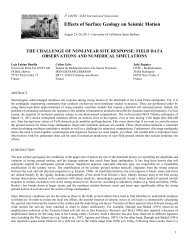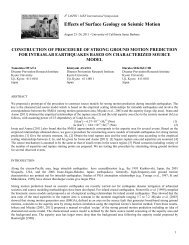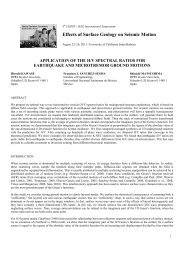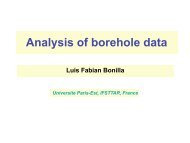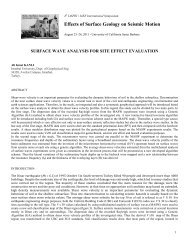a new strategy for developing vs30 maps - ESG4 Conference @ UCSB
a new strategy for developing vs30 maps - ESG4 Conference @ UCSB
a new strategy for developing vs30 maps - ESG4 Conference @ UCSB
Create successful ePaper yourself
Turn your PDF publications into a flip-book with our unique Google optimized e-Paper software.
The geology-based <strong>strategy</strong> can provide very useful Vs 30 <strong>maps</strong> in some cases (e.g., Wills and Clahan, 2006; Wills and Gutirrez, 2008).<br />
Yet, there remains a substantial amount of subjectivity in turning the (often) large number of geological units into the sufficiently few<br />
groupings needed <strong>for</strong> numerically assigning median Vs 30 values to each; there are insufficient Vs 30 data to constrain all individual<br />
units. Since some or many of the units within the groups have not been sampled by Vs 30 measurements, the uncertainty of the Vs 30<br />
values are not accounted <strong>for</strong> and are, in fact, solely dependent on subjective geological inferences. Furthermore, grouping geological<br />
units and assigning a Vs 30 value to each grouping results in a constant value over large areas of the map (e.g., Fig. 1c, after Lee et al.,<br />
2001), even though the Vs 30 observations show much greater, often systematic, spatial variations within those groups (e.g., compare<br />
Fig. 1b and 1c). Worse, in many seismically active regions of the world, in<strong>for</strong>mation about surficial geology and Vs 30 either does not<br />
exist, varies dramatically in resolution and quality, varies spatially, or is not available in digital <strong>for</strong>m.<br />
Fig. 1. A) Left: Topographic map of Taiwan at 30 arcsec (~1 km) sampling from STRM data; see legend <strong>for</strong> elevations. Circles<br />
denote Vs 30 observations (downhole measurements from Lee et al., 2001); color fill is Vs 30 values (m/sec) as given by NEHRP<br />
categories shown in the Vs 30 legend. B) Middle: Map of Vs 30 values predicted from the Wald and Allen (2007) model relating<br />
topographic-slope to Vs 30 . C) Right: Geologic-based Vs 30 map of Lee et al. (2001); note Lee et al. (2001) use only four discrete<br />
categorical geology units.<br />
Topographic elevation data, on the other hand, are available at uni<strong>for</strong>m sampling <strong>for</strong> the globe (e.g., SRTM data, Farr and Kobrick,<br />
2000). Recognizing the global availability of high-resolution topographic data, Wald and Allen (2007) proposed an alternative<br />
approach to systematically estimating and thus mapping Vs 30 using topographic slope as a predictor of Vs 30 . By taking the gradient of<br />
the topography and choosing ranges of slope that maximize the correlation with shallow shear-velocity observations, they could<br />
recover, to first order, many of the spatially varying features of site-condition <strong>maps</strong> developed <strong>for</strong> tectonically-active regions like<br />
Taiwan and Cali<strong>for</strong>nia, as well as <strong>for</strong> the low-relief, stable-craton regions like the Mississippi Embayment. Notably, the topographicslope<br />
approach also predicted the bulk of the Vs 30 observations in these regions despite being derived <strong>for</strong> much wider data sets (Wald<br />
and Allen, 2007; Allen and Wald, 2009). Unlike the geology-based approach, the slope-based <strong>strategy</strong> predicts Vs 30 values that<br />
preserve the character of the observed spatial variations (e.g., compare the Vs 30 observations in Fig. 1a with Fig. 1b). Subsequent<br />
analyses of the topographic-slope proxy <strong>for</strong> Vs 30 have shown convincing results (e.g., Wills and Gutierrez, 2008; Thompson et al.,<br />
2011) in particular regions, though slope alone was certainly not expected to work well under all geological or geomorphic domains<br />
(Wald and Allen, 2007).<br />
Intuitively, topographic variations should be an indicator of near-surface geomorphology and lithology to the first order, with steep<br />
mountains indicating rock, nearly flat basins indicating soil, and a transition between the end members on intermediate slopes. Slope<br />
of topography, or gradient, should be diagnostic of Vs 30 , because more competent (high-velocity) materials are more likely to maintain<br />
a steep slope whereas deep basin sediments are deposited primarily in environments with very low gradients. Furthermore, particle<br />
size or sediment fineness, itself a predictor of lower Vs (e.g., Park and Elrick, 1998), should relate to slope. For example, steep, coarse,<br />
mountain-front alluvial fan material typically grades to finer deposits with distance from the mountain front as is deposited at<br />
decreasing slopes by less energetic fluvial and ultimately pluvial processes.<br />
3



